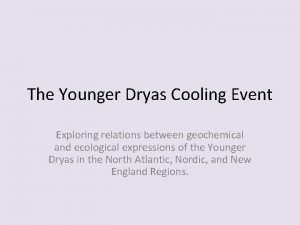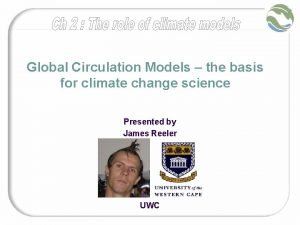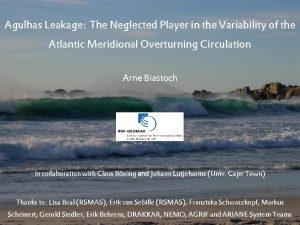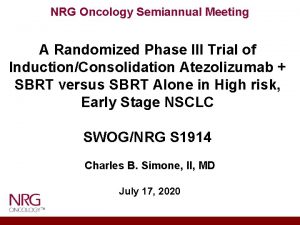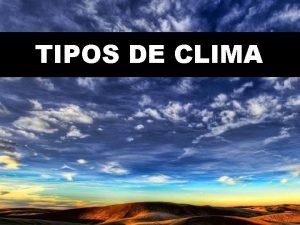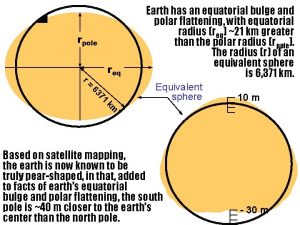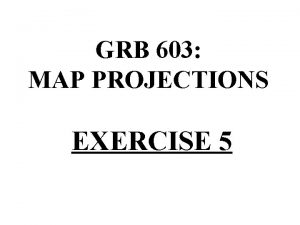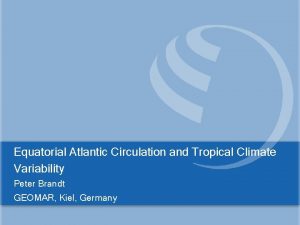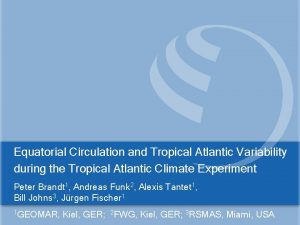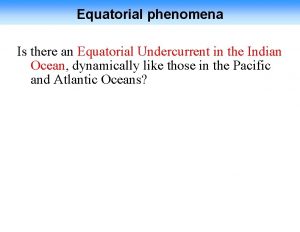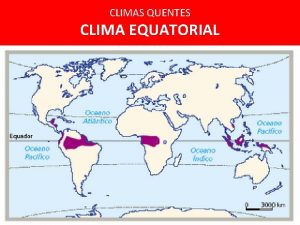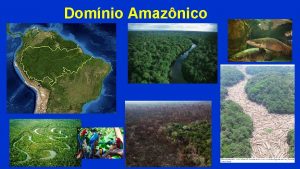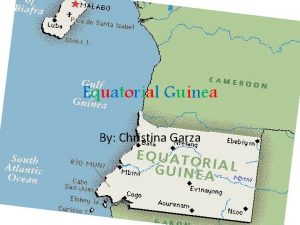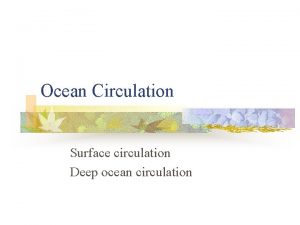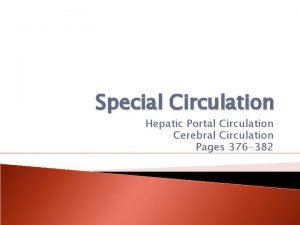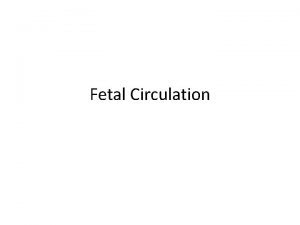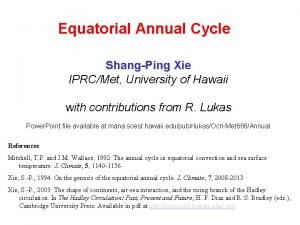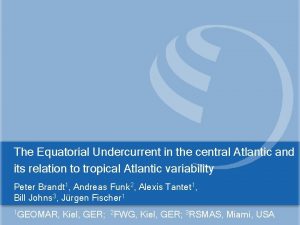Annual and semiannual cycle of equatorial Atlantic circulation













- Slides: 13

Annual and semi-annual cycle of equatorial Atlantic circulation associated with basin mode resonance Peter Brandt (1), Martin Claus (1), Richard J. Greatbatch (1), Robert Kopte (1), John M. Toole (2), William E. Johns (3), and Claus W. Böning (1) GEOMAR, Kiel, Germany (2) Woods Hole Oceanographic Institution, Woods Hole, MA, USA (3) RSMAS/MPO, University of Miami, FL, USA Brandt et al. (2016) JPO, in revision

Equatorial circulation variability with focus on seasonal variability Equatorial mooring at 23°W within different programs (BMBF Nordatlantik, SFB 754) in cooperation with PIRATA: full-depth zonal velocity with different instrumentation Equatorial Undercurrent Equatorial Deep Jets with downward phase and upward energy propagation Study is based on equatorial velocity data, and simulations with a general circulation model and a reduced gravity model

Baroclinic mode decomposition • Mean temperature/salinity profile at 23°W is used to calculate vertical structure functions (baroclinic modes) and corresponding phase velocities, cgw • Phase velocities will be used to setup the linear reduced-gravity model Blue: Red: Yellow: 4 th baroclinic mode 2 nd baroclinic mode mean zonal velocity with EUC core at about 70 m depth

Kinetic energy distrubution at 23°W Frequency spectra of observed zonal velocity from the equator, 23°W and baroclinic mode spectra of the annual (solid) and semi-annual (dashed) cycles

Horizontal structure of dominant variability in TRATL 01 • maximum zonal velocity amplitude at the equator in mid-basin • meridionally broader structure for the 2 nd baroclinic mode • generally westward phase propagation Strong similarities with resonant equatorial basin modes 2 nd baroclinic mode, semi-annual cycle 4 th baroclinic mode, annual cycle

Equatorial Basin Modes Basics: • Cane and Moore (1981) described low-frequency standing equatorial modes composed of equatorial Kelvin and long Rossby waves • Period of the gravest basin mode: Applications: • Resonance of 2 nd baroclinic mode semi-annual cycle in the Indic (Jensen 1993, Han et al. 1999) and Atlantic (Thierry et al. 2004, Ding et al. 2009) • Resonance of intraseasonal variability in the Indic (Han et al. 2005, Fu 2007) • EDJ behavior (Johnson and Zhang 2003, d‘Orgeville et al. 2007, Greatbatch et al. 2012)

Energy of zonal flow at 23°W: basin mode oscillations • Most of the energy is concentrated on only three frequencies • All peaks are associated with resonant linear equatorial basin modes Black line: basin mode characteristic from Ph. D thesis, M. Claus

Basin mode resonance in the reduced-gravity model RMS zonal velocity in a reduced-gravity model forced by harmonically oscillating, spatially uniform zonal wind stress for a square basin (solid line) and a realistic coastline basin (dashed line) 4 th baroclinic mode 2 nd baroclinic mode

Basin mode simulations with the reduced-gravity model • harmonically oscillating, zonal and meridional wind forcing derived from observations (NCEP-DOE AMIP-II Reanalysis product) • realistic coastline basin 2 nd baroclinic mode, semi-annual cycle 4 th baroclinic mode, annual cycle

Horizontal structure of dominant variability in TRATL 01 • Comparison with the GCM solution 2 nd baroclinic mode, semi-annual cycle 4 th baroclinic mode, annual cycle

Basin mode simulations with the reduced-gravity model • Some characteristics simulated by the GCM TRATL 01 are reproduced by the linear reduced-gravity model Basin modes are governed by linear wave dynamics 2 nd baroclinic mode, semi-annual cycle 4 th baroclinic mode, annual cycle

Reconstruction of Equatorial Undercurrent core velocity and core depth at 23°W EUC core velocity is dominated by the 4 th baroclinic mode semi-annual cycle and the EUC core depth by the 2 nd baroclinic mode semi-annual cycle Core Depth (m) Core Velocity (cms-1) Observations Reconstructions At mean EUC core depth, 4 th baroclinic mode (blue) is close to zero and 2 nd baroclinic mode (red) large

Summary • Resonant equatorial basin modes are ubiquitous features of the equatorial Atlantic Ocean • Equatorial deep jets (baroclinic mode 15 -20) • Annual cycle (baroclinic mode 4) • Semi-annual cycle (baroclinic mode 2) • Basin modes are governed by linear wave dynamics • Seasonal variability of the Equatorial Undercurrent can largely be explained by the linear superposition of the two dominant equatorial basin modes • Amplitude and phase of the seasonal cycle in GCMs depends on the basin resonance, i. e. on vertical density structure, strength of thermocline, etc.
 Single circulation and double circulation
Single circulation and double circulation Single circulation and double circulation
Single circulation and double circulation Structure of bronchiole
Structure of bronchiole Atlantic meridional overturning circulation
Atlantic meridional overturning circulation Slowing atlantic ocean circulation
Slowing atlantic ocean circulation Atlantic meridional overturning circulation
Atlantic meridional overturning circulation Nrg oncology meeting 2017
Nrg oncology meeting 2017 Nrg oncology semiannual meeting
Nrg oncology semiannual meeting Nrg oncology semi annual meeting 2018
Nrg oncology semi annual meeting 2018 Clima intertropical
Clima intertropical Equatorial radius of the earth
Equatorial radius of the earth Equatorial radius of the earth
Equatorial radius of the earth Gnomonic equatorial zenithal projection
Gnomonic equatorial zenithal projection Equatorial region vegetation
Equatorial region vegetation



